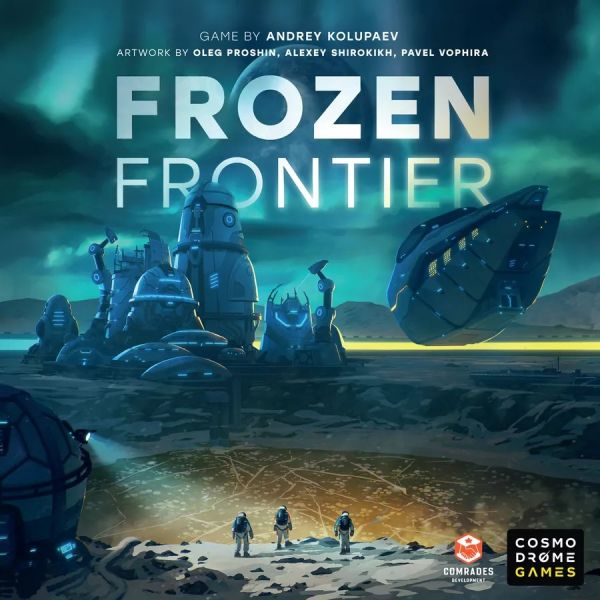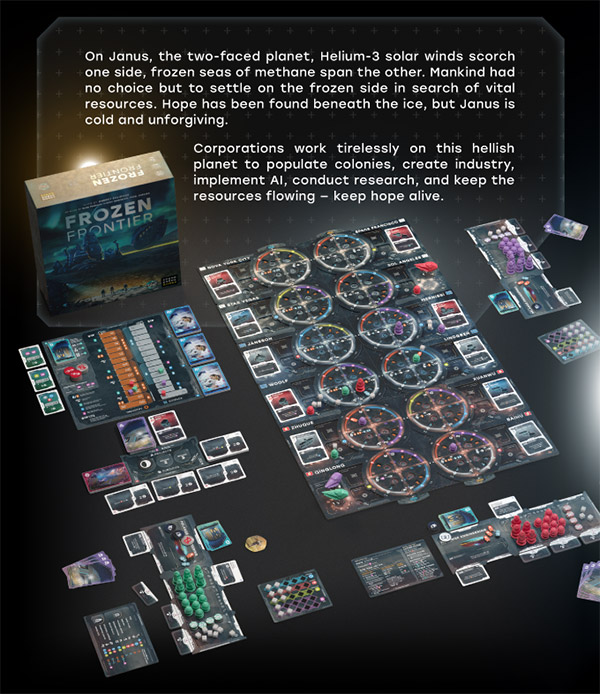Preview: Compete with Rival Corporations to Settle Space in Frozen Frontier

Now on Kickstarter, Frozen Frontier is the latest game from Cosmodrome Games and Arcane Wonders. This strategic Eurogame combines engine building, area majority, and multi-use cards to build up a future in which Earth nations are now establishing themselves in the vast environs of space to gather resources to send back to the home planet.
Gameplay
Rather than do a traditional deep-dive into the mechanics for this preview, it’s best to focus on what players are doing and how it affects the game. The central board is constructed of tiles each having two city locations, each with four spots for specific building types and a fifth spot for transportation hubs. These city boards will be put together in a certain configuration (the number of tiles used is dependent on player count). Players will be navigating to these cities, collecting cards, and completing actions with those cards to build up these cities, gain currency, influence, and bonuses in the great space chase toward having the most points after three rounds.
Players will take on the role of a corporation that will have asymmetrical bonuses on the completion of specific actions. On an individual’s turn, they will move to a city, collect a card from the board (if it’s still present), and then complete a main action. These main actions are either Construct, Collaborate, or Raise Funds. If a player chooses to Construct, they will play a card from their hand which allows them to construct a building in that city. Players must be able to either match the city they are in with the card they possess (for example, a player wanting to build in Woolf must have a card that is specific to Woolf) or match the building type they are looking to construct (for example, a player may possess a card which allows them to build a Power Plant in Woolf, but they are in Baihu but Baihu has an available Power Plant spot). Players will play the card, pay the cost of the building, and place it in the available area. Doing so will allow players to gain the building’s effects, which can be resources or movement up the Industry or Science tracks. If a player uses a card that matches both the building and the city (from the examples, a player using a Woolf Power Plant card to build a Power Plant in Woolf), they may choose to complete the project and gain the benefit printed on the bottom half of the card. These can be ongoing or one-time effects that players will tuck under the player boards. At the beginning of a game, only two slots are open for players to use but as players climb up the Industry track, they can open up to three more spots for completed projects. If players cannot or choose not to complete a project, they may select a Subsidy card, gain its benefits, discard and replace it, and their turn is over.
The Collaborate action allows players to settle scientists and engineers in cities where they have placed buildings. Scientists and engineers are gained via advancing up their respective tracks (Science and Industry) and gaining players victory points. These tracks are important for not only gaining slots and scientists and engineers, but also Shipment cards (more on that later) and Research cards. Research cards are benefits that allow players additional bonuses based on the actions they take. Research 1 and 2 cards are ongoing benefits and each player will choose one when they pass that space on the Science track. Research 3 cards represent end-of-game bonuses and players also can choose which one they want (if available) when they reach that space.
Collaborating also allows players to spend their Qubits (currency) to collect the resources from buildings or the basic resources outside the city. Players may also collect laboratory effects, which offer further victory point opportunities, which coordinate with each building quadrant in a city. Finally, the Raise Funds action allows players to collect 3 Qubits and use one of the Subsidiary cards. Subsidiary cards allow players to gain Qubits, resources, and sometimes the ability to spend those to place AI bots in cities. These AI bots are part of the area control that occurs within each city, and count as one point toward control totals at the end of the game.
A quirk of Frozen Frontier is the dual purpose of Qubits. Not only are Qubits a form of currency, but they help players keep track of their resources. There are four resources: Aerogel, Energy, Regolith, and Helium3. These resources are monitored via a player tracker, with any empty spaces representing the number of available resources of that type. When a resource is used, a Qubit from the player’s own supply is used on that resource’s track to fill in the empty space, meaning players are essentially costing themselves money when they spend resources. However, gaining resources can occur via the bonuses gained by completing projects, advancing on tracks, using Subsidiary cards, and building Hubs in cities to collect the transit tax that is incurred if players move their ship more than one space in a turn (each additional space costs players on Qubit per city).
Helium3 is the most vital resource in the game. As the game progresses and rounds end, players will need to be able to mandatorily spend Helium3 to avoid losing 5 points. Helium3 is also the main resource that Earth residents are requesting. At the end of each round, players will be fulfilling Shipments that require a specific amount of resources. The player highest up on the Industry track will get to choose which Shipment they will fulfill, and then in descending order, the rest of the players will choose a Shipment card to fulfill. These will provide victory points at the end of the game, as well as immediate bonuses in the form of Qubits.
Play continues through three rounds, with Subsidiary cards acting as round timers. After the first two rounds, there will be the Income phase, Shipment phase, and Cleanup phase. Income phase is simple, as players will receive any Qubits that were used when Collaboration with their buildings occurred, and players owning Hubs will gain any Qubits that are sent to the transit tax spot. The Shipment Phase is where players will fulfill Shipment cards after fulfilling the Mandatory shipment of Helium3 to Earth. During the course of the game, players are also able to gain individual Shipment cards from advancing on the Industry track as well as from bonuses gained from completing projects. Finally, the Cleanup phase has players shuffle and then deal out Subsidiary cards to start the new round, replenishing cards to each city space, adding scientists and engineers based on where they are on the respective tracks, and replenishing Shipment cards. At the end of the third round, players will add up all victory points gained during the game, as well as end-of-game points earned from fulfilled shipments and research cards, and control within each city by the number of buildings and AI bots they have in the city. a winning galactic corporation is declared.

Frozen Frontier components (adapted from the Kickstarter campaign)
Review
Frozen Frontier was reviewed from a prototype copy, so the rule set may not be finalized. That said, despite the seeming heft of the rules and actions at one’s disposal, Frozen Frontier is not an overwhelming game or an incredibly hard game to learn. The player aids make it very simple to know what to do as far as mechanisms are concerned, with each action also being easily relatable to more casual and family-friendly games people are familiar with. The trick of Frozen Frontier will be in understanding how all of the elements coalesce into a sound, functional strategy that allows players to experience the fun the game offers without the head-scratching and hair-pulling moments of frustration in trying to strategize the best course of action.
The game largely boils down to getting the resources to build the small and large buildings in a city and doing it to maximize the asymmetrical power of your corporation while also synergizing those with bonuses gained from completing actions. In other words, it’s a very traditional engine builder with some great additions in the form of multi-use cards and game pieces to add to the overall puzzle. And it’s these fiddly parts that may make people frustrated with the game’s scope. Is it better to just solely focus on a perfected engine of gaining resources and fulfilling contracts? Should you race up one or both tracks? Is it best to gain control of as many cities as possible or concentrate influence on just a couple of cities close together and exploit those areas?
Which leads to the beauty of Frozen Frontier: all those are viable options to winning the game. And that flexibility further lessens the learning curve. Players can sit down, play the game, and devise a strategy that best suits their style and fun level without worrying that they are falling behind by focusing on what makes them comfortable. The game also does not penalize players for getting out from under their engines occasionally to do something else that may benefit them in the short or long term.
Frozen Frontier isn’t perfect. The rules are still a bit too hefty considering the game itself isn’t nearly as complex as the rules would have one believe. But setup is a chore and will likely be a deterrent for people looking for a game that has easy setup. The game, especially after the first play, can be completed as quickly as 60-70 minutes if all players are familiar enough with the basic rules, but setup for a 3 or 4-player game may take 10 minutes on its own. And if you’re trying to teach the game and setup, it’s going to be much longer and you may find players who were curious about the game’s theme and mechanics feeling more daunted and overwhelmed before they can sit down and try it out.
However, I suggest anyone who is looking at taking their love of engine-building games to the next level, give Frozen Frontier a serious consideration. For casual-only gamers, the deluxe price tag may be too much for them to stomach. But considering the deluxification of the hobby as a whole (for the benefit of some, the detriment of others), you’ll get a lot out of Frozen Frontier and its subtle variability. Yes, the theme may be a bit hackneyed at this point, but how Frozen Frontier implements it via the game’s mechanics is a great refresh for a genre that isn’t going to leave the hobby anytime soon. Frozen Frontier is now live on Kickstarter.
Pros: Satisfying engine-building, solid combination of mechanics, simplified player aids make knowing what to do and what is gained easy to understand
Cons: The price may be off-putting for some, the current rules are a bit too bogged down in minutiae when the game’s basic actions are fairly cut and dry




